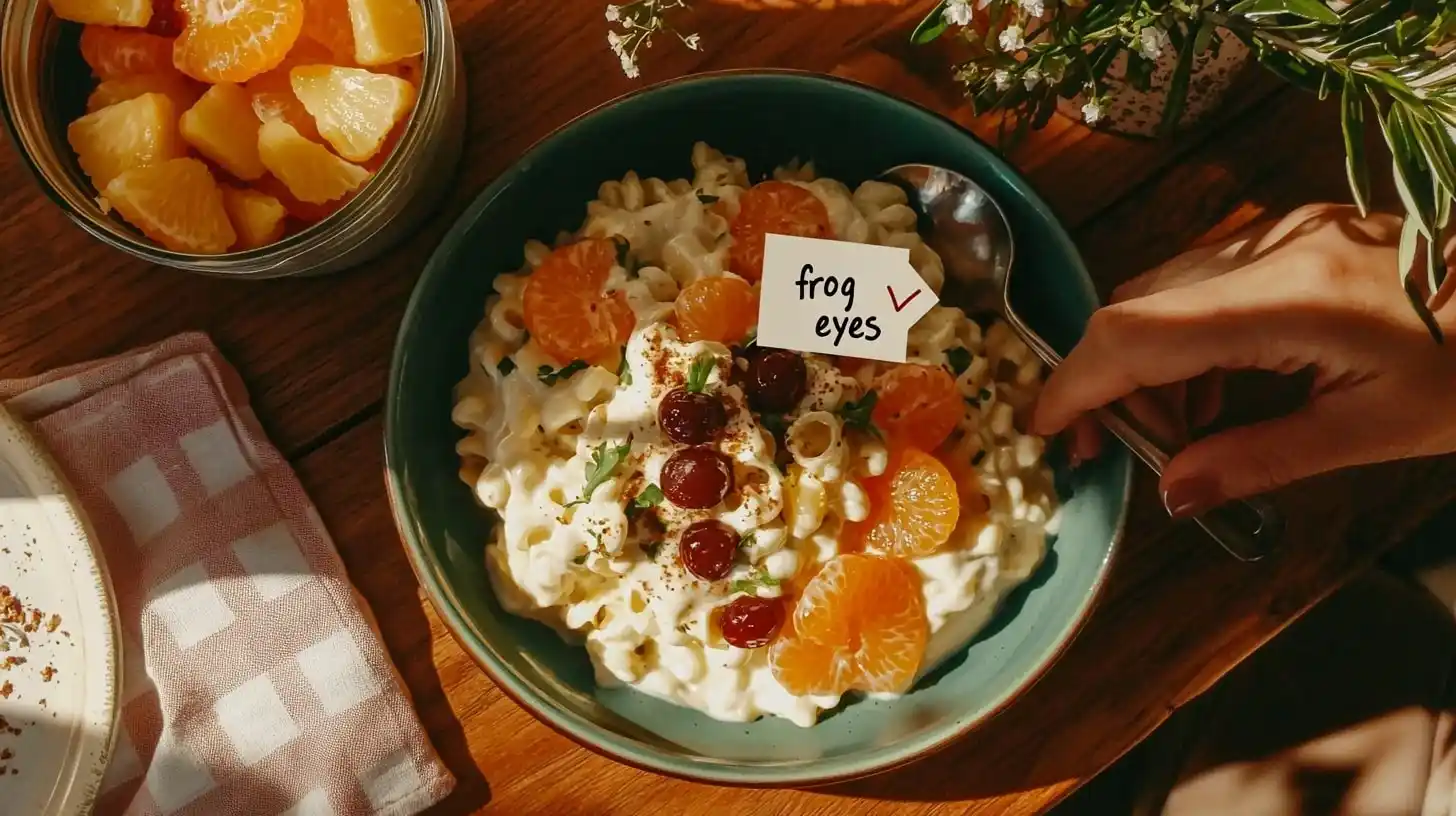The first time I mentioned making frog eye salad for a neighborhood potluck, my husband’s co-worker (who had recently moved from overseas) looked absolutely horrified. “You’re bringing… what?” he stammered, clearly imagining some bizarre amphibian concoction. I couldn’t help but laugh as I explained that despite its eyebrow-raising name, this beloved dish contains no actual frogs – just tiny pasta pearls that playfully resemble little frog eyes swimming in a sweet, creamy mixture.
This memorable interaction highlights why “What is Frog Eye Salad?” remains one of the most common questions I receive after sharing my Frog Eye Salad recipe. The confusion is understandable, as the name doesn’t exactly advertise what’s actually in this unique dessert that straddles the line between pasta salad and sweet treat.
Table of Contents
The Basic Definition: What Actually Is It?What is Frog Eye Salad?
Frog Eye Salad: A sweet dessert featuring tiny acini di pepe pasta pearls (the ‘frog eyes’) mixed with fruit and cream – despite the quirky name, no amphibians are involved!
At its heart, frog eye salad is a sweet pasta-based dessert salad made with tiny round pasta, fruit, and a creamy pudding mixture. The core components include:
- Acini di pepe pasta: These small, round pasta pearls are the “frog eyes” that give the dish its whimsical name. When cooked, they swell to about the size of tapioca pearls, creating a pleasantly chewy texture that contrasts beautifully with the soft fruit.
- Fruit components: Typically pineapple chunks, mandarin oranges, and maraschino cherries, though variations abound.
- Creamy base: A sweet pudding-like mixture usually made with egg, sugar, flour, pineapple juice, and whipped topping or whipped cream.
My youngest daughter’s description might be the most accurate: “It’s like if pudding and pasta had a baby, and then that baby made friends with fruit.” Children often grasp the essence of unusual combinations better than adults with preconceived notions about what belongs together!What is Frog Eye Salad?
The Cultural Background: Where Did It Come From?
Frog eye salad is deeply rooted in American potluck culture, particularly in the Intermountain West region. My Kentucky grandmother never made this dish – I first encountered it after moving west and attending a neighborhood gathering where three different variations appeared on the table.
The dish is especially popular in Utah and is often associated with Mormon community gatherings, though its appeal has spread throughout the United States. Its origins likely date to the mid-20th century, when creative pasta salads and molded gelatin dishes were at the height of popularity.
My neighbor Elaine, whose Mormon grandmother passed down their family recipe through five generations, explains that the dish represents practical ingenuity: “It stretches expensive ingredients like fruit with affordable pasta, feeds a crowd, and travels well – perfect for large family gatherings.”What is Frog Eye Salad?.
The Regional Variations: How Does It Change Across America?

Frog eye salad adapts to regional tastes: Midwestern style (left), Utah/Mormon tradition (center), and Southern variation (right) – each with unique ingredient twists!
Like any beloved recipe that travels across regions, frog eye salad has developed distinctive variations:
The Utah/Mormon Classic
The traditional version typically uses acini di pepe pasta, mandarin oranges, pineapple, a cooked vanilla pudding base, and whipped topping. This version often includes miniature marshmallows and sometimes coconut. At a church potluck in Salt Lake City, I watched as children bypassed the chocolate cake to request second helpings of this version.
The Midwestern Adaptation
In Midwestern states, the salad sometimes incorporates additional fruits like grapes or apples, and occasionally nuts for texture. My sister-in-law from Minnesota adds a touch of lemon zest “to brighten things up,” as she puts it – a small but significant regional twist.
The Southern Twist
In Southern states, the dish sometimes gets extra richness with the addition of pecans and extra maraschino cherries, occasionally with a splash of the cherry juice for color. A friend’s grandmother in Georgia apparently added a tablespoon of bourbon to her version “for the adults,” though she’d never admit it at Sunday social.
The Common Questions: What People Wonder About Frog Eye Salad
As someone who regularly brings this conversation-starting dish to gatherings, I’ve fielded countless questions about it:
Is it a dessert or a side dish?
This remains delightfully ambiguous and varies by region. In the Midwest, it’s often served alongside savory dishes like a traditional side salad. In Utah and other western states, it’s more commonly classified as a dessert. In my home, we’ve settled on calling it a “dessert salad” – a compromise that satisfies no one but works for everyone.
Can you make it ahead of time?
Not only can you make it ahead, but it actually improves with time. The pasta absorbs the sweet flavors of the pudding mixture and the fruit juices meld together. My husband calls it “overnight magic” because the transformation between freshly made and next-day frog eye salad is so remarkable.
Why use pasta in a sweet dish?
This question, often asked with a wrinkled nose, reflects our rigid categorization of ingredients. I remind skeptics that many beloved desserts cross these imaginary boundaries – rice pudding uses a grain typically served in savory dishes, after all. My middle child points out that “pasta is just flour and water, and so is cake, kind of” – a simplified but effective argument!
The Modern Appeal: Why It Endures
Despite changing food trends and more sophisticated palates, frog eye salad maintains its popularity for several compelling reasons:
- Nostalgia factor: For many adults, it recalls childhood gatherings and family traditions
- Textural interest: The chewy pasta, soft fruit, and creamy pudding create a satisfying mouthfeel
- Versatility: The basic recipe welcomes adaptation to personal preferences
- Conversation value: In an age of Instagram-perfect food, its quirky name and appearance stand out
When my children help me prepare it for gatherings, they’re connecting to a broader American food tradition that spans generations and regions. My oldest daughter has already declared it will be her contribution to college potlucks – “No one else will bring anything like it,” she observed correctly.
If you’re curious about making this unique conversation-starting dessert, my Frog Eye Salad recipe provides step-by-step guidance for creating this beloved American classic in your own kitchen.What is Frog Eye Salad?.
With warmth, Sophia





